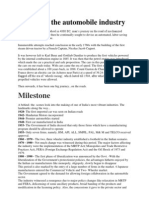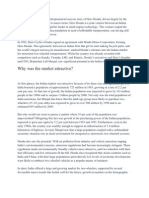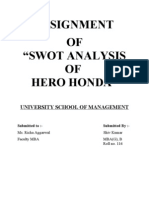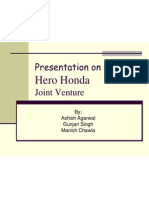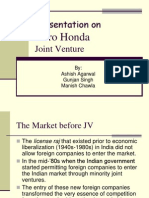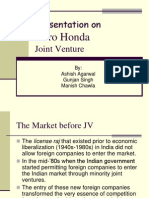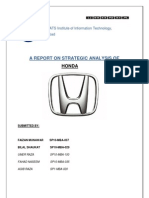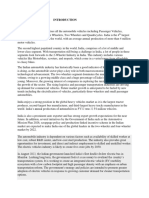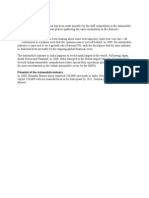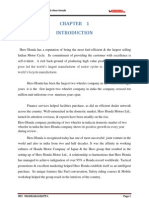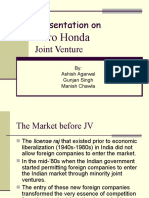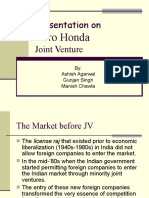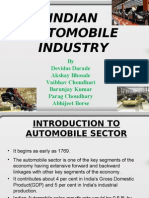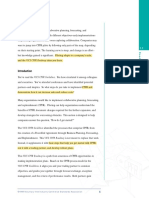Macro Analysis of The Indian Motorbike Industry
Macro Analysis of The Indian Motorbike Industry
Uploaded by
Pooja YamiCopyright:
Available Formats
Macro Analysis of The Indian Motorbike Industry
Macro Analysis of The Indian Motorbike Industry
Uploaded by
Pooja YamiOriginal Title
Copyright
Available Formats
Share this document
Did you find this document useful?
Is this content inappropriate?
Copyright:
Available Formats
Macro Analysis of The Indian Motorbike Industry
Macro Analysis of The Indian Motorbike Industry
Uploaded by
Pooja YamiCopyright:
Available Formats
Macro Analysis of the Indian Motorbike Industry
STEEPLED ANALYSIS
1) SOCIAL FORCES
- Lack of roads that were suitable for four wheelers increased the demand for 2 wheelers
- Two Wheelers were a priced possession.
- Expensive four wheelers. The time and the opportunity were apt and Hero Honda stuck the cord at the
right time in all the strata including the tier 1 and tier 2 cities (the initial penetration of two wheelers being
around 10%). This created a social impact and brought about change.
2) TECHNOLOGICAL FORCES
- four-stroke engines were superior to the incumbent two-stroke engines in multiple areas Hero Honda had
the first and for many years only four-stroke vehicle (except for Royal Enfield’s 346 cc four-stroke)
-These four stroke engines were more efficient, less fuel consuming, long lasting and gave a better milage
than a two-stroke engine or a scooter.
3) ECONOMIC FORCES
- India had a penetration rate of less than 10% which was way below that of other Developing countries so
the Indian market had a huge space to grow this helped Hero convince Honda that a large population
coupled with emerging market economic situation constituted an excellent market for affordable,
motorized, two-wheeled scooters.
- Further the economic crash or 2008 proved to be a boon for Hero Honda as their nearest rivals focused on
high end bikes while they focused on affordability.
4) ENVIRONMENTAL FORCES
- Government becoming strict with the emission regulations made environmentally friendly vehicles more
attractive and two wheelers with fuel efficiency and low emissions fit the bit
- Four stroke engine of Hero Honda was less polluting than two stroke ones. Hero Honda bike was fuel
efficient and gave a better mileage.
5) POLITICAL & LEGAL FORCES
- In the mid 1980’s the government started permitting foreign companies to enter the Indian Market through
minority joint ventures with domestic alliance partners. The restrictive government policies in the pre
liberalization era prevented foreign companies from making investment in India which was changed by the
1991 reforms, thus setting up the red carpet for Honda to make a mark in the Indian automobile sector with
Hero.
-License raj prevented and prohibited the foreign company from investing in India however FIPB
regulations enabled the Hero to join hands with Honda, thus opening up the market creating accessibility.
6) ETHICAL FORCES
- Environmentally sound technology is the ethical orientation that Hero Honda has.
- Hero Honda actually delivered what they initially promised and actually realized the slogan ‘Fill it, Shut
it, Forget’ it in reality
- This led to an increase in their market share and reputation
7) DEMOGRAPHIC FORCES
- With the Indian population growing at 2.1% every, the adult age group has the highest possibility of
buying two-wheelers (15–65-year-olds) and increased to more than 500 million by 1990 and to an
approximate 700 million by 2006.
- 5.2% increase in the per capita income over the next 10 years.
- By 2000, motorcycles were the choice of 60 per cent of India’s two-wheeled customers, up from 33 per
cent in 1996.
- Increasing rural urban migration, Urban population density and traffic congestion in metro cities.
You might also like
- Kohavi, Diane Tang, Xu - Trustworthy Online Controlled Experiments - A Practical Guide To AB Testing (2020)Document290 pagesKohavi, Diane Tang, Xu - Trustworthy Online Controlled Experiments - A Practical Guide To AB Testing (2020)Phoebe WangNo ratings yet
- ATP AT34 Instrument User Manual - Ver 2Document44 pagesATP AT34 Instrument User Manual - Ver 2jcpreditiva.solucoesNo ratings yet
- History of The Automobile IndustryDocument3 pagesHistory of The Automobile IndustryAnkita ChatterjeeNo ratings yet
- DP Physics Topic 5 Quiz1 AnswersDocument2 pagesDP Physics Topic 5 Quiz1 AnswersRiddhi Dixit100% (1)
- Macro Analysis of The Indian Motorbike Industry Saptarshi Chatterjee, Roll No.: 010, MBA-A Steepled Analysis of Hero HondaDocument1 pageMacro Analysis of The Indian Motorbike Industry Saptarshi Chatterjee, Roll No.: 010, MBA-A Steepled Analysis of Hero HondaLAVINA JESWANINo ratings yet
- So What Went Wrong For Peugeot India?: Bajaj AutoDocument10 pagesSo What Went Wrong For Peugeot India?: Bajaj AutoRaja SunderNo ratings yet
- Macro-Environmental Drivers of Market Attractiveness: Application To An Indian Joint Venture Rushi Anandan, SIMSRDocument14 pagesMacro-Environmental Drivers of Market Attractiveness: Application To An Indian Joint Venture Rushi Anandan, SIMSREsha ChaudharyNo ratings yet
- Industry ProfileDocument11 pagesIndustry ProfilecharanNo ratings yet
- Hero HondaDocument17 pagesHero HondaAshwani KumarNo ratings yet
- Azam PasDocument14 pagesAzam PasSheikh AzamNo ratings yet
- This Case Study Details The Entrepreneurial Success Story of Hero HondaDocument4 pagesThis Case Study Details The Entrepreneurial Success Story of Hero HondaSantosh KumarNo ratings yet
- Assignment OF "Swot Analysis OF Hero Honda": University School of ManagementDocument18 pagesAssignment OF "Swot Analysis OF Hero Honda": University School of ManagementPadma627No ratings yet
- Hero Honda SwotDocument18 pagesHero Honda Swotmaahi811100% (9)
- Final ProjectDocument48 pagesFinal ProjectAmit DevrukhkarNo ratings yet
- Chapter 3Document16 pagesChapter 3Jagadish Kumar BobbiliNo ratings yet
- Presentation On Joint Venture: Hero HondaDocument11 pagesPresentation On Joint Venture: Hero HondaZeeshan JawaidNo ratings yet
- Presentation On Joint Venture: Hero HondaDocument11 pagesPresentation On Joint Venture: Hero Hondasandeepsindhu99No ratings yet
- Her Oho NdaDocument11 pagesHer Oho NdamrinalharshaNo ratings yet
- Tammina Avinash: By: MBA 09MO45Document12 pagesTammina Avinash: By: MBA 09MO45Srikanth ReddyNo ratings yet
- Presentation On Joint Venture: Hero HondaDocument11 pagesPresentation On Joint Venture: Hero HondaSridhar JeedipellyNo ratings yet
- Report of 2 WheelerDocument6 pagesReport of 2 WheelerAzad KrishanNo ratings yet
- The Two Wheeler IndustryDocument59 pagesThe Two Wheeler IndustryChandan SinhaNo ratings yet
- Hero HondaDocument50 pagesHero HondaDinesh RamawatNo ratings yet
- Business Strategy and PolicyDocument16 pagesBusiness Strategy and PolicyBilal ShaukatNo ratings yet
- "Growth of Two Wheeler in India" A Case Study: ND RDDocument4 pages"Growth of Two Wheeler in India" A Case Study: ND RDchitraanandNo ratings yet
- Breakup of The Industry by Segment: Segmentation of Two WheelerDocument28 pagesBreakup of The Industry by Segment: Segmentation of Two WheelersushantgawaliNo ratings yet
- Industry AnalysisDocument38 pagesIndustry AnalysisIbrahim RaghibNo ratings yet
- Hero Honda-Comple - NewDocument20 pagesHero Honda-Comple - NewJoseph H. BauerNo ratings yet
- Tata Motors 2012: Fuel and Propulision TechnologiesDocument88 pagesTata Motors 2012: Fuel and Propulision TechnologiesParth AggarwalNo ratings yet
- Honda UnicornDocument77 pagesHonda UnicornushadgsNo ratings yet
- Hindustan Motors: # Plants State Year Started Collaboration Products 1Document25 pagesHindustan Motors: # Plants State Year Started Collaboration Products 1Ritesh KumarNo ratings yet
- Project ReportDocument78 pagesProject ReportMukul Srivastava100% (1)
- Study of Consumer PreferenceDocument78 pagesStudy of Consumer PreferenceParshant GargNo ratings yet
- MKTNG Plan BIKEDocument39 pagesMKTNG Plan BIKESunil ParwaniNo ratings yet
- Motorbikes Full PDFDocument14 pagesMotorbikes Full PDFPratima ChaudharyNo ratings yet
- Hero Honda Motors India LTD Is It HondaDocument24 pagesHero Honda Motors India LTD Is It HondaDebasya SahooNo ratings yet
- A Major Project Report EMBA DTU Shailender Sharma 2K13MBA520 123Document64 pagesA Major Project Report EMBA DTU Shailender Sharma 2K13MBA520 123Jahid KhanNo ratings yet
- Denny (1) ReportDocument22 pagesDenny (1) ReportDenny FrankNo ratings yet
- Hero HondaDocument46 pagesHero Hondamaisha_nsuNo ratings yet
- Hero HondaDocument33 pagesHero HondaManu PalegarNo ratings yet
- Case Study HondaDocument14 pagesCase Study HondaArun SharmaNo ratings yet
- Presentation On Joint Venture: Hero HondaDocument11 pagesPresentation On Joint Venture: Hero HondaNissar BadharudheenNo ratings yet
- Presentation On Joint Venture: Hero HondaDocument11 pagesPresentation On Joint Venture: Hero HondamamatadaleiNo ratings yet
- Presentation On Joint Venture: Hero HondaDocument11 pagesPresentation On Joint Venture: Hero Hondapreyas_shah_1No ratings yet
- Presentation On Joint Venture: Hero HondaDocument11 pagesPresentation On Joint Venture: Hero HondaAditya SundaramNo ratings yet
- Presentation On Hero HondaDocument11 pagesPresentation On Hero HondaAlia AlsafarjlaniNo ratings yet
- Presentation On Joint Venture: Hero HondaDocument11 pagesPresentation On Joint Venture: Hero HondaNiwradoNo ratings yet
- Auto IndustryDocument19 pagesAuto IndustryAditya SharmaNo ratings yet
- Hero Honda Motors (India) LTD.: Is It Honda That Made It A Hero?Document17 pagesHero Honda Motors (India) LTD.: Is It Honda That Made It A Hero?JatinMahaJanNo ratings yet
- FinalDocument25 pagesFinalakki_bhosaleNo ratings yet
- Justice K. S. Hegde Institute of ManagementDocument43 pagesJustice K. S. Hegde Institute of ManagementAnup KumarNo ratings yet
- Honda ActivaDocument79 pagesHonda Activagoswamiphotostat100% (1)
- Automobile Industry JigneshDocument48 pagesAutomobile Industry JigneshHarshad JivaniNo ratings yet
- Rationale To The StudyDocument14 pagesRationale To The Studysauravv7No ratings yet
- HHJHBDocument4 pagesHHJHBGaurav VermaNo ratings yet
- Internship ReportDocument35 pagesInternship ReportRaval JayNo ratings yet
- Case Study HondaDocument14 pagesCase Study HondaJonela LazaroNo ratings yet
- Honda: The Engine of Innovation - A Comprehensive Journey Through Bikes and CarsFrom EverandHonda: The Engine of Innovation - A Comprehensive Journey Through Bikes and CarsNo ratings yet
- Research Proposal PDFDocument7 pagesResearch Proposal PDFammaraNo ratings yet
- Online Pixel DPI Calculator Converter Conversion - PPI Calculate Photo - Image - Pictur and Photo Calculate Size For Printing and EditingDocument4 pagesOnline Pixel DPI Calculator Converter Conversion - PPI Calculate Photo - Image - Pictur and Photo Calculate Size For Printing and EditingPavan KumarNo ratings yet
- 07-The Copy Posse Lead Magnet GuideDocument6 pages07-The Copy Posse Lead Magnet GuideSunil Kumar100% (2)
- Federated Inception-Multi-Head Attention Models For Cyber Attacks DetectionDocument17 pagesFederated Inception-Multi-Head Attention Models For Cyber Attacks DetectionIAES IJAINo ratings yet
- WRO 2018 WeDo RegularDocument14 pagesWRO 2018 WeDo RegularAlaas AlvcaszaNo ratings yet
- 8202-031 and 531 Electrical Theory Exam Summer 2017-pdf - AshxDocument11 pages8202-031 and 531 Electrical Theory Exam Summer 2017-pdf - Ashxnkxqbwqk22No ratings yet
- Confidential: Reference Check FormDocument3 pagesConfidential: Reference Check FormAbdullah Abdulkareem AlJabarNo ratings yet
- 2013 ILX Maintenance - Xls - MaintenanceDocument1 page2013 ILX Maintenance - Xls - MaintenanceGawker.comNo ratings yet
- WebsitesDocument64 pagesWebsitesamitbansal999No ratings yet
- 4 2020 Big Data Analytics For Cyber-Physical System in Smart City - 663, 768Document2,049 pages4 2020 Big Data Analytics For Cyber-Physical System in Smart City - 663, 768morteza hosseiniNo ratings yet
- VellutinoDocument39 pagesVellutinojorgedacunhaNo ratings yet
- Quantum MeasurentDocument9 pagesQuantum MeasurentaakulapichaiahNo ratings yet
- Year 9 DT 2015 Assessment Task 3Document8 pagesYear 9 DT 2015 Assessment Task 3api-299002247No ratings yet
- DU Undergraduate Math Hons Syllabus As Per CBCSDocument63 pagesDU Undergraduate Math Hons Syllabus As Per CBCSkthesmart4No ratings yet
- Hafiz Danish ZahidDocument7 pagesHafiz Danish ZahidShoaib AliNo ratings yet
- CPFR RoadmapDocument24 pagesCPFR RoadmapalegabipachecoNo ratings yet
- Ge1gc545wbxu1145luimzzrlSetting Plan 18.05.2023 MDocument4 pagesGe1gc545wbxu1145luimzzrlSetting Plan 18.05.2023 MGarena BotNo ratings yet
- Isolated Col or Pad FoundationDocument8 pagesIsolated Col or Pad FoundationLeroy LifestyleNo ratings yet
- Honda DTC Codes PDFDocument12 pagesHonda DTC Codes PDFZayn SilangNo ratings yet
- Project Synopsis FormatDocument4 pagesProject Synopsis FormatKamil GourNo ratings yet
- L U N C H: B V C Institute of Technology and Science: AmalapuramDocument4 pagesL U N C H: B V C Institute of Technology and Science: AmalapuramVamsi RamNo ratings yet
- 2024 Prospectus School of Agriculture and Fisheries SciencesDocument332 pages2024 Prospectus School of Agriculture and Fisheries SciencesqualityrepeatNo ratings yet
- The Mathematical Parent: Parental Scaffolding, Parenting Style, and Learning Outcomes in Long-Division Mathematics HomeworkDocument18 pagesThe Mathematical Parent: Parental Scaffolding, Parenting Style, and Learning Outcomes in Long-Division Mathematics Homeworksuharyadi suwakburNo ratings yet
- The Nature Study - Harvest MoonDocument20 pagesThe Nature Study - Harvest Moondj8hnkgppbNo ratings yet
- Introduction Power Supply PPT 1Document51 pagesIntroduction Power Supply PPT 1Rokiah Juman0% (1)
- Cambridge Assessment International Education: This Document Consists of 13 Printed PagesDocument13 pagesCambridge Assessment International Education: This Document Consists of 13 Printed PagesDeni NurdiantoNo ratings yet
- Typical Systems Depiction For PIDsDocument38 pagesTypical Systems Depiction For PIDsRaghNo ratings yet


